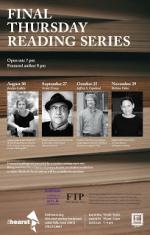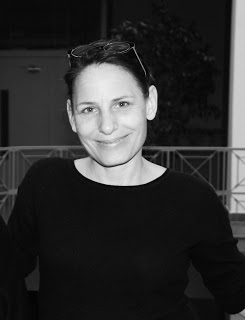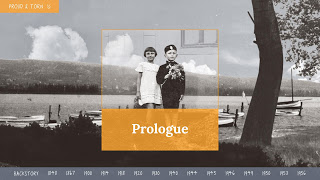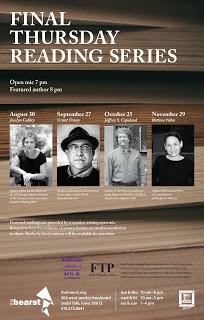
The North American Review is proud to be published at the University of Northern Iowa, located in Cedar Falls, Iowa. In keeping with our pride in our academic community, the North American Review is sharing interviews conducted for the Final Thursday Reading Series in Cedar Falls. Now in its 19th season, the Final Thursday Reading Series features regional authors presenting their recent work. Prior to the featured reader, an open mic gives local writers a chance to find a friendly audience for original poetry, fiction and creative nonfiction. FTRS takes place on the final Thursday of each month at the Hearst Center for the Arts in Cedar Falls, Iowa. FTRS is a collaboration of Final Thursday Press, the Hearst Center for the Arts and the UNI College of Humanities, Arts & Sciences. Today, we feature their reader for Novemeber and the original interview can be found here.

Bettina Fabos will be the featured reader at the Final Thursday Reading Series on November 29 at the Hearst Center for the Arts (Open mic at 7:15; Bettina Fabos at 8:00). Fabos is a Professor of Visual Communication and Interactive Digital Studies at the University of Northern Iowa. In the following interview, she discusses working on Proud and Torn: A Visual Memoir of Hungarian History, a unique digital project.
Proud & Torn is not just about the history of your family but also about Hungarian history. Can you describe what it was like to weave the two together?
BETTINA FABOS: My goal was to show how one poor, everyday, peasant family, as well as their neighbors in the small town they inhabited, both succeeded and suffered under the decisions of people in power. To me, history comes to life when you bring in the personal narrative. So, I simultaneously looked at these big historical markers, most often from “official” history, like revolutions, wars, and regime change, and tried to explore these events through the eyes of my own family members. In this way, I hoped to convey this history so it feels more real and memorable.
Using a digital medium allowed you to do things with images, graphics, and transitions that you would not have been able to in a regular book. What made you choose to use a digital medium instead, and what do you think the advantages were?
BF: I teach in a program at UNI called Interactive Digital Studies, and I’m always inspired by beautiful, tangible web projects. I love the interactivity of parallax storytelling pioneered by the developers of the first great New York Times web project, “Snowfall.” I love the tension you get by scrolling vertically to move images horizontally (as we’ve done with our timeline interface), and I love coming across looped videos online that don’t take any time to view, but add movement and dimension to an article or story. We wanted Proud & Torn to be something people would enjoy exploring.
Proud & Torn must have been an enormous undertaking. You mention in the epilogue that you were interviewing Ari in 2005. How long did it take to do all of the research for this project?
BF: I let those early interviews with Ari (my father’s sister) and my father languish for about seven years, and I began an early version of the project in 2012. I received a Fulbright research grant to do research in photo archives in Hungary. Then my project really began to transform, because it was initially intended to be a rather short project that I could design/code on my own. But while there I had a growing unease that I couldn’t treat Hungarian history lightly—there were too many implications if I got it wrong. I also met two young American historians of Hungary (Leslie Waters and Kristina Poznan, also Fulbright recipients) who were very excited about what I was doing, and they pushed me to expand the project into a social history of the small town my family was from. I took two years to draft the story, and while I was drafting, we were designing and coding. The process of building every chapter took months, and in the end it took a full six years to complete.
You cover a wide range of history in the memoir, from how Hungary was founded to the lives of your parents. Is there anything you found during your research that surprised you?
BF: It was fascinating to learn that my Hungarian family members were serfs working on land owned by the famous Széchényi (pronounced SAY-chain-ee) family. This family—the Széchényis—are legendary for their own involvement in building Hungary’s national identity. Everywhere in Budapest there is the Széchényi name: on the first bridge linking Buda to Pest, on the national library, on the Academy of Sciences, on the majestic thermal spa in Budapest’s city park. It turns out they owned land all over Hungary, including the castle in the town my family lived in. I chose to tell the story of the Széchényis parallel with the story of my family, and in doing so I am telling the story about power, class mobility, and social disruption. My favorite moment in Proud & Torn is when the once wealthy Széchényi countess, who had been kicked out of the family castle as the Communist regime came to power after World War II, bartered with my Aunt Ari for a sack of potatoes using one of her beautiful silver spoons. Ari still uses this spoon every day like it’s one of her prize possessions. I always knew she had the spoon, but I never fully understood the history behind it. 
Why is the piece called Proud & Torn?
BF: Throughout the narrative, I’m constantly referring to “pride”: the pride of Hungarian nationalism, which rose to new heights with the Compromise of 1867 and still drives the narrative of “greater” Hungary today; the pride of Hungary’s agricultural success as the breadbasket of the Austrian Empire; the pride of Budapest’s amazing culture and architecture at the turn of the century; the pride and success of Hungarian Jewish culture; Hungary’s prideful sporting achievements, especially in fencing, figure skating (1930s) and soccer (1950s); my own family’s pride at their advancement into the middle class; the individual pride of my own father surviving torture. Too often, Hungary’s pride has veered into a dangerous nationalism, which has been the root of Hungary and its people being “torn,” even today. The nationalistic Hungarians were on the losing side of World War I, where the countryside, cities, people, relationships, and the ways of life were ripped up beyond repair. With the Treaty of Trianon in 1920, Hungarians were astonished to see Hungary reduced to one-third of its size, demoralizing an entire nation and sending three million Hungarians to live across the border in other countries, torn from their identity as Hungarians. The wretched horror of World War II (a war Hungary was also on the wrong side of, allying with Nazi Germany to regain territory) resulted in more tearing, with the Holocaust being the most extreme example. This was followed by the ransacking of Hungary, this time by the Russians, the ripping up of aristocratic estates (down to the parquet floors), the upending of class structure, and the tearing of families from their homes and livelihoods under new economic plans. Ultimately, with the failed Hungarian Revolution of 1956, my father left for the United States, although he would have preferred to stay in Hungary. Like so many other Hungarian families, this one, too, was torn apart. That is the story of Hungary: proud and torn.
-- Interview conducted by Brooke Wiese



